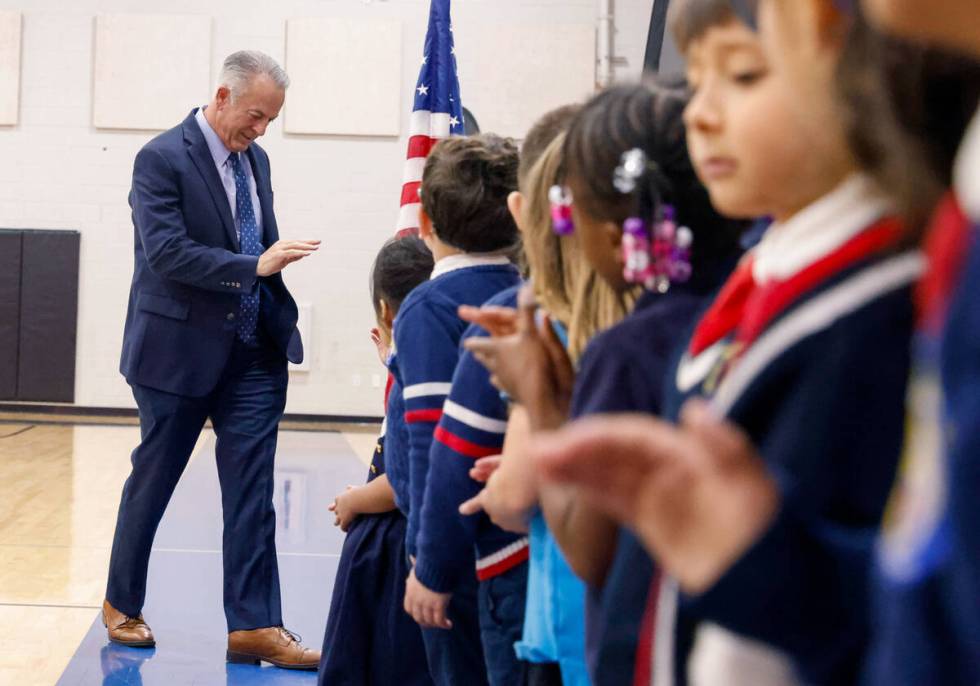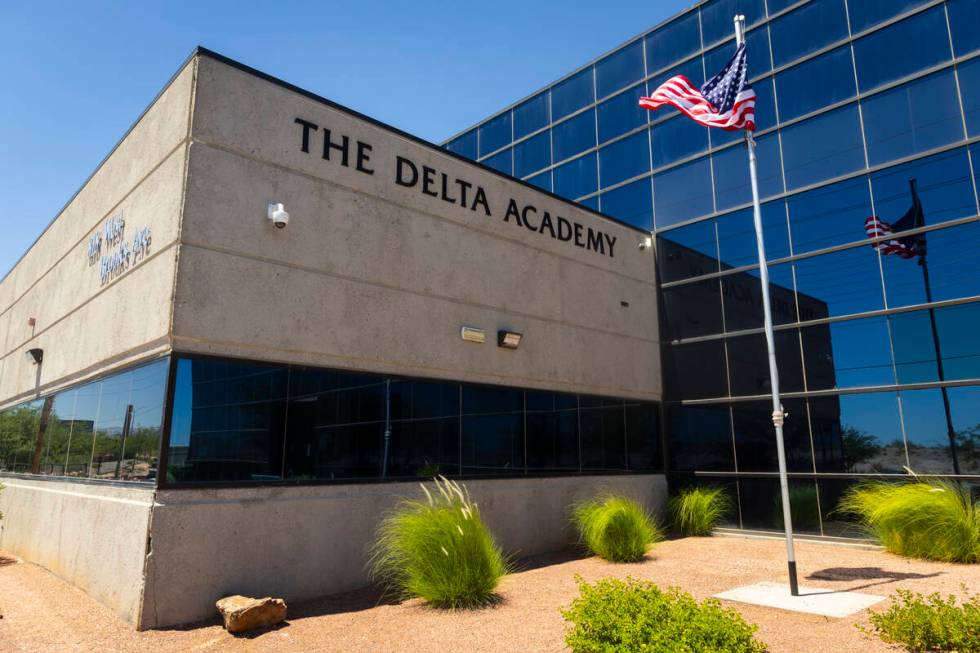More students opt for charter schools as CCSD enrollment falls
Trenton Mitchell was struggling to pay attention in middle school, so much so that he began failing some classes.
His mom, Traci Mitchell, knew he needed a change. Despite her older daughter’s success in the Clark County School District, she switched her son to a charter school. Two years later, she said the 14-year-old is excelling in The Delta Academy’s online program, which also allows the active teenager the flexibility to play more football.
“As a parent, you have to read your child,” Mitchell said. “When there are options involved, that makes it so much better.”
The Mitchell family is part of an increasing population opting for charter schools over traditional public schools. Between the 2019-2020 school year and the 2024-2025 school year, the number of students in Clark County attending charter schools grew by 26 percent, to 64,128 students, according to the Nevada Department of Education. In that same time period, Clark County School District enrollment declined by over 8 percent, while Southern Nevada’s population increased by 5 percent.
Headed into the start of the school year on Monday, the school district estimates its enrollment at 285,707. That is the lowest in over 20 years, when it was 280,840 students in the 2004-2005 school year. Enrollment increased most years after that it until it reached a peak of 330,227 students in the 2018-2019 school year. Then began the decline.
A pandemic that closed schools, political debates over education and low test scores have led to drops in public school enrollment every year, experts say. That trend leaves CCSD schools, which receive funding based on the number of students enrolled, seeking more money for fewer students. But whether that should lead to more investment in the traditional public school system or more investment in alternatives remains a divisive topic, both in Nevada and around the country.
“Parents make their own choices for their children,” said Jeremy Heckler, president of the National Education Association of Southern Nevada educators union. “But as a whole, we talk about one pie of money for us all. When we make those pies smaller, and the issues that we have in education continue to be the same or get bigger, it doesn’t resolve our problems, it just adds to them.”

The politics of school choice
School choice is a polarizing topic in education.
Republican Gov. Joe Lombardo has pledged to increase school choice options, while the Democratic majority in the Legislature has been wary of investments in alternatives to traditional public school. This past session, a combined bill from Lombardo and Senate Majority Leader Nicole Cannizzaro, D-Las Vegas, ultimately included expanded transportation funding for students to move to another school. Legislators also approved charter school pay raises, which was a shift from 2023, when only CCSD teachers received pay raises.
At the same time, many education advocates were disappointed in the education budget. Lombardo signed the state’s $12.9 billion education budget, increasing per-pupil funding by $2 per student. That was something that many education advocates saw as too little of an increase, after the historic education funding increase passed in 2023, when the Nevada education budget allocated almost $12 billion in education spending, which was a $2.6 billion dollar increase in education funding over the two years.
The education bill signed by Lombardo in May provides an average of $13,889 per pupil in 2026 and $13,963 in 2027, amounts that are still well below the national average of about $17,000 annually.
“As we are going through all of these issues with enrollment, these issues with the budget … if we don’t really address them and we continue to two-dollar, for lack of a better term, education, those problems get bigger. They don’t get better,” Heckler said.
On the other side, school choice advocates argue that funding has done little to improve education in Nevada.
“More funding has been allocated in Nevada for traditional public schools every single year in the name of making schools better. I’m not saying that we shouldn’t continue investing in them, but we need clear expectations that funding is not going to be the full solution to the problem that is bigger than that,” said Valeria Gurr, a senior fellow at the American Federation for Children.

Pandemic, politics and poor performance
There are several potential reasons local families are shifting away from CCSD. The COVID-19 pandemic, for one, drew many families to homeschooling. Private school enrollment has increased by more than 17 percent since the pandemic, according to the Nevada Department of Education.
“We saw a lot of changes post pandemic in the views of families, realizing that when the public schools literally shut down their doors to the community and left them with no options, a lot of families started learning about homeschooling, about micro schools, about private schools, about charter schools, about magnet schools,” Gurr said.
The pandemic also drove a more than 10 percent increase in the number of Nevada households homeschooling their children, according to census data.
Parents of children attending CCSD schools also worry about their students’ safety, about low proficiency scores year after year and culture wars over education. Both charter schools and public schools can expel students. However, charter schools have a greater latitude to expel students than traditional CCSD public schools, according to state Sen. Michelee Cruz-Crawford, D-North Las Vegas, who is also an elementary school principal.
It was not until a bill passed in the 2025 session that CCSD schools could move bullies out of a specific school. With that bill, the students transfer to another school in the district.
Given Nevada’s per-pupil funding formula, schools get less money when enrollment declines.
That happened in January, when the school district sent schools individual budget projections in January, and most elementary schools were short anywhere from $750,000 to more than $1 million, Vicki Kreidel said at the time, when she was president of the National Education Association of Southern Nevada.
“It does make things more difficult for administrators trying to figure out how things are going to go with their school, and makes things ridiculously difficult for teachers because of the transiency and changes that go along with it,” Heckler said.
The challenge of adding charter schools
Starting a charter school is a lot more difficult than many might expect, according to UNLV Professor Megan Griffard, who researches and teaches education policy. The application to open a charter school requires thousands of hours of work and hundreds of pages of documentation.
Las Vegas, Henderson and North Las Vegas officials rejected all of the proposed charter schools this year. The reasons included proximity to a school and officials’ arguments that they were not offering anything new or different enough from a CCSD option.
Many existing charter schools have long wait lists and can’t fit everyone who wants to attend. For the 2025-2026 school year, the popular Coral Academy charter school has almost 6,000 students waiting for spots across its seven campuses, according to data provided by the school.

Griffard said research shows that charter schools bring competition into the marketplace, thereby improving existing public schools.
“If there are more charter schools in a certain area, and it’s affecting enrollment of the traditional public schools, researchers tend to believe that that pushes the traditional public schools in the neighborhood to become more innovative, to make themselves more appealing and more competitive in the marketplace to get kids to choose to enroll in the traditional public school versus a charter school,” Griffard said.
Some charter schools also offer options for students whose needs may not be met in CCSD. Strong Start Academy has a dual-language program, something most CCSD schools do not offer. Delta’s online program helps kids like Mitchell, who have more time to play sports.
Griffard has seen CCSD respond to charter schools by diversifying its portfolio, with more public schools offering more STEM programming and musical theater.
Additionally, magnet schools have seen increased enrollment since before the pandemic.
Within CCSD, magnet schools offer specialized programs, such as performing arts, math or science, that typically require an application or lottery process. At the end of the 2024-2025 school year, 35,373 students were enrolled in CCSD’s magnet schools. That was up almost 12 percent from the 2019-2020 school year.
In 2014, the school district added 11 magnet schools to its existing 25 magnet campuses. As of 2025, there are 45 magnet schools, according to Gia Moore, the district’s assistant superintendent of College and Career Readiness and School Choice. Part of that expansion was facilitated by federal grants, Moore said. Moore said a large part of the growth of magnet schools has come from the school district recognizing that it was not meeting demand from valley families.
A student can also apply to go to a different school within the district. CCSD’s change-of-school assignment process, known as COSA, has been around since the 1970s. The school district gets around 17,000 applications a year to change schools, Moore said.
When it comes to declining enrollment in the school district, Moore said, the district sees it as an opportunity to continue to improve.
“It’s a concern across the country, declining enrollment. So what do you do? You have to figure out what families need, and you have to either do more of that, or you have to do better at what you’re offering,” Moore said. “And I know that’s a priority for our district.”
Contact Katie Futterman at kfutterman@reviewjournal.com. Follow @ktfutts on X. Review-Journal reporter Spencer Levering contributed to this report.


















